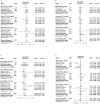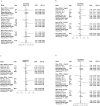Association between perfluoroalkyl substances exposure and thyroid function in adults: A meta-analysis
- PMID: 29746532
- PMCID: PMC5945046
- DOI: 10.1371/journal.pone.0197244
Association between perfluoroalkyl substances exposure and thyroid function in adults: A meta-analysis
Abstract
Objective: Many people are exposed to perfluoroalkyl substances (PFASs) because these substances are widely used as industrial products. Although epidemiological studies suggest that PFASs can disrupt thyroid hormones, the association between PFAS exposure and thyroid function remains inconclusive. Therefore, we performed a comprehensive meta-analysis to investigate the association between PFASs exposure and thyroid hormones.
Methods: We searched medical literature databases for articles on the association between PFASs-perfluorooctanesulfonic acid (PFOS), perfluorooctanoic acid (PFOA), and perfluorohexane sulfonic acid (PFHxS)-and thyroid hormone levels in adults. Twelve articles were included in the meta-analysis, and the pooled z values were calculated with correlation or regression coefficients.
Results: The blood PFOS concentration was positively correlated with free T4. The pooled z value was 0.05 (95% confidence interval (CI): 0.03, 0.08). PFOS was negatively correlated with total T4 and total T3 when excluding outlier studies. In a subgroup analysis stratified by mean PFOS concentration, PFOS was observed to be positively associated with free T4 and TSH and negatively associated with total T3 in the intermediate concentration group (8-16 ng/mL). PFOA concentration was negatively correlated with total T4 (z value, -0.06; 95% CI: -0.09, -0.03) after omitting one outlier study. PFHxS also showed a negative correlation with total T4 (z value, -0.04; 95% CI: -0.07, -0.01). A subgroup analysis of pregnant women showed that there was no association between PFASs and thyroid hormones.
Conclusions: Our meta-analysis suggests that PFASs are negatively associated with total T4, and their effect can be different depending on the PFAS concentration.
Conflict of interest statement
Figures




Similar articles
-
Associations between perfluoroalkyl acids (PFASs) and maternal thyroid hormones in early pregnancy: a population-based cohort study.Environ Res. 2014 Aug;133:338-47. doi: 10.1016/j.envres.2014.06.012. Epub 2014 Jul 12. Environ Res. 2014. PMID: 25019470
-
Cross-Sectional Associations of Serum Perfluoroalkyl Acids and Thyroid Hormones in U.S. Adults: Variation According to TPOAb and Iodine Status (NHANES 2007-2008).Environ Health Perspect. 2016 Jul;124(7):935-42. doi: 10.1289/ehp.1409589. Epub 2015 Oct 30. Environ Health Perspect. 2016. PMID: 26517287 Free PMC article.
-
Exposure to perfluoroalkyl substances (PFAS) and associations with thyroid parameters in First Nation children and youth from Quebec.Environ Int. 2019 Jul;128:13-23. doi: 10.1016/j.envint.2019.04.029. Epub 2019 Apr 24. Environ Int. 2019. PMID: 31029975
-
Associations between per- and polyfluoroalkyl substances exposure and thyroid hormone levels in the elderly.Sci Total Environ. 2024 Apr 10;920:170761. doi: 10.1016/j.scitotenv.2024.170761. Epub 2024 Feb 8. Sci Total Environ. 2024. PMID: 38340830 Review.
-
The Association of Hypertension with Perfluoroalkyl and Polyfluoroalkyl Substances.Int Heart J. 2023 Nov 30;64(6):1079-1087. doi: 10.1536/ihj.23-036. Epub 2023 Nov 14. Int Heart J. 2023. PMID: 37967990
Cited by
-
Association of per- and polyfluoroalkylated substances/heavy metals and bone health in children and adolescents.Front Public Health. 2024 Oct 10;12:1431001. doi: 10.3389/fpubh.2024.1431001. eCollection 2024. Front Public Health. 2024. PMID: 39450387 Free PMC article.
-
Monthly Variations in Perfluorinated Compound Concentrations in Groundwater.Toxics. 2018 Sep 14;6(3):56. doi: 10.3390/toxics6030056. Toxics. 2018. PMID: 30223455 Free PMC article.
-
Exposure to perfluoroalkyl substances and neonatal immunoglobulin profiles in the upstate KIDS study (2008-2010).Environ Pollut. 2022 Sep 1;308:119656. doi: 10.1016/j.envpol.2022.119656. Epub 2022 Jul 1. Environ Pollut. 2022. PMID: 35787426 Free PMC article.
-
Metals and per- and polyfluoroalkyl substances mixtures and birth outcomes in the New Hampshire Birth Cohort Study: Beyond single-class mixture approaches.Chemosphere. 2023 Jul;329:138644. doi: 10.1016/j.chemosphere.2023.138644. Epub 2023 Apr 7. Chemosphere. 2023. PMID: 37031836 Free PMC article.
-
On the swelling behavior of poly(N-Isopropylacrylamide) hydrogels exposed to perfluoroalkyl acids.J Polym Sci (2020). 2021 Feb 15;59(4):289-299. doi: 10.1002/pol.20200805. Epub 2021 Jan 3. J Polym Sci (2020). 2021. PMID: 34859243 Free PMC article.
References
-
- Fromme H, Tittlemier SA, Volkel W, Wilhelm M, Twardella D. Perfluorinated compounds—exposure assessment for the general population in Western countries. Int J Hyg Environ Health. 2009;212(3):239–70. doi: 10.1016/j.ijheh.2008.04.007 . - DOI - PubMed
-
- Calafat AM, Wong LY, Kuklenyik Z, Reidy JA, Needham LL. Polyfluoroalkyl chemicals in the U.S. population: data from the National Health and Nutrition Examination Survey (NHANES) 2003–2004 and comparisons with NHANES 1999–2000. Environ Health Perspect. 2007;115(11):1596–602. doi: 10.1289/ehp.10598 . - DOI - PMC - PubMed
-
- Environmental Protection Agency (EPA). Draft Risk Assessment of the Potential Human Health Effects Associated with Exposure to Perflouroctanoic Acids and Its Salts. 2005.
-
- Grandjean P, Clapp R. Perfluorinated Alkyl Substances: Emerging Insights Into Health Risks. New Solut. 2015;25(2):147–63. doi: 10.1177/1048291115590506 . - DOI - PMC - PubMed
-
- Bach CC, Bech BH, Brix N, Nohr EA, Bonde JP, Henriksen TB. Perfluoroalkyl and polyfluoroalkyl substances and human fetal growth: a systematic review. Crit Rev Toxicol. 2015;45(1):53–67. doi: 10.3109/10408444.2014.952400 . - DOI - PubMed
Publication types
MeSH terms
Substances
LinkOut - more resources
Full Text Sources
Other Literature Sources

